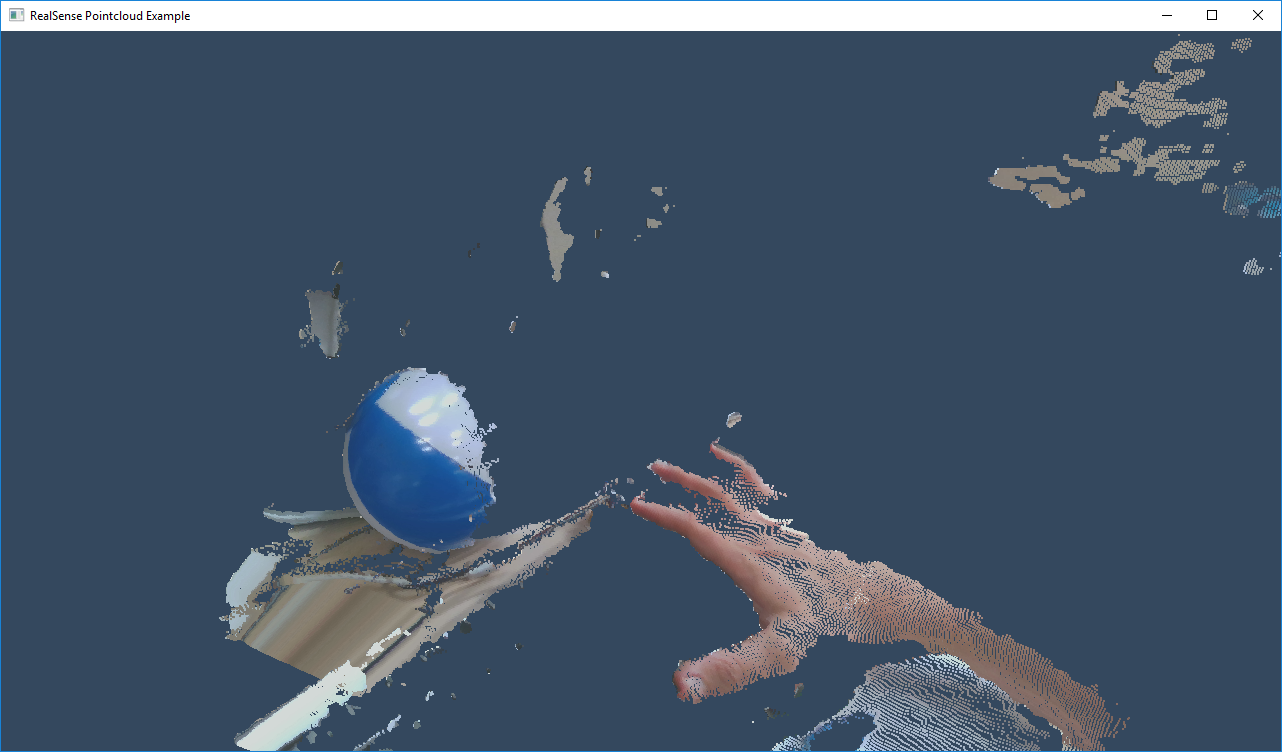This sample demonstrates how to generate and visualize textured 3D pointcloud.
The application should open a window with a pointcloud. Using your mouse, you should be able to interact with the pointcloud rotating and zooming using the mouse.
Similar to the first tutorial we include the Cross-Platform API:
#include <librealsense2/rs.hpp> // Include RealSense Cross Platform APINext, we prepared a very short helper library encapsulating basic OpenGL rendering and window management:
#include "example.hpp" // Include short list of convenience functions for renderingWe also include the STL <algorithm> header for std::min and std::max.
Next, we define a state struct and two helper functions. state and register_glfw_callbacks handle the pointcloud's rotation in the application, and draw_pointcloud makes all the OpenGL calls necessary to display the pointcloud.
// Struct for managing rotation of pointcloud view
struct state { double yaw, pitch, last_x, last_y; bool ml; float offset_x, offset_y; texture tex; };
// Helper functions
void register_glfw_callbacks(window& app, state& app_state);
void draw_pointcloud(window& app, state& app_state, rs2::points& points);The example.hpp header lets us easily open a new window and prepare textures for rendering. The state class (declared above) is used for interacting with the mouse, with the help of some callbacks registered through glfw.
// Create a simple OpenGL window for rendering:
window app(1280, 720, "RealSense Pointcloud Example");
// Construct an object to manage view state
state app_state = { 0, 0, 0, 0, false, 0, 0, 0 };
// register callbacks to allow manipulation of the pointcloud
register_glfw_callbacks(app, app_state);We are going to use classes within the rs2 namespace:
using namespace rs2;As part of the API we offer the pointcloud class which calculates a pointcloud and corresponding texture mapping from depth and color frames. To make sure we always have something to display, we also make a rs2::points object to store the results of the pointcloud calculation.
// Declare pointcloud object, for calculating pointclouds and texture mappings
rs2::pointcloud pc;
// We want the points object to be persistent so we can display the last cloud when a frame drops
rs2::points points;The Pipeline class is the entry point to the SDK's functionality:
// Declare RealSense pipeline, encapsulating the actual device and sensors
pipeline pipe;
// Start streaming with default recommended configuration
pipe.start();Next, we wait in a loop unit for the next set of frames:
auto data = pipe.wait_for_frames(); // Wait for next set of frames from the cameraUsing helper functions on the frameset object we check for new depth and color frames. We pass it to the pointcloud object to use as the texture, and also give it to OpenGL with the help of the texture class. We generate a new pointcloud.
// Wait for the next set of frames from the camera
auto frames = pipe.wait_for_frames();
auto depth = frames.get_depth_frame();
// Generate the pointcloud and texture mappings
points = pc.calculate(depth);
auto color = frames.get_color_frame();
// Tell pointcloud object to map to this color frame
pc.map_to(color);
// Upload the color frame to OpenGL
app_state.tex.upload(color);
Finally we call draw_pointcloud to draw the pointcloud.
draw_pointcloud(app, app_state, points);draw_pointcloud is primarily calls to OpenGL, but the critical portion iterates over all the points in the pointcloud, and where we have depth data, we upload the point's coordinates and texture mapping coordinates to OpenGL.
/* this segment actually prints the pointcloud */
auto vertices = points.get_vertices(); // get vertices
auto tex_coords = points.get_texture_coordinates(); // and texture coordinates
for (int i = 0; i < points.size(); i++)
{
if (vertices[i].z)
{
// upload the point and texture coordinates only for points we have depth data for
glVertex3fv(vertices[i]);
glTexCoord2fv(tex_coords[i]);
}
}